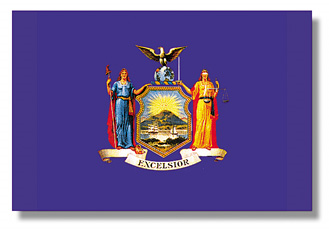New York State Functions
The State Government
Government in New York State is essentially a partnership between the state and the local units of government - cities, towns and villages. All of the elements of the state government - the Legislature, the office of the Governor, the courts and the vast administrative structure - are engaged in activities for which the local governments also share responsibility. To understand local government fully, it is necessary to gain a basic understanding of the state government and its far-reaching activities.
Our federal system of government divides responsibilities between the national and state governments. The states, in turn, delegate much power to local governments. The entire system calls for fiscal and political accountability at each government level - from the White House to the village hall.
The interdependence and interrelationships among the Office of the Governor, the State Legislature, state agencies, and local governments are important to know. We must understand the grants of authority, the scope of jurisdiction, the organization and the operative processes of the executive, legislative, judicial and administrative elements of state government in relation to the other elements and to the local government function. The Governor makes policy and provides administrative leadership and direction; the Legislature also makes policy and implements it by enacting legislation and appropriating funds. State agencies carry out the actual programs of state government, and act as intermediaries and close working partners with local governments. By providing a check and balance on the system, the courts also play an integral part in the operation of state and local government. We will discuss the courts in the following chapter.
The Legislature and the Legislative Process
The Constitution of the State of New York vests the lawmaking power of the state in the Legislature. It is a bicameral, or two-house, legislative body consisting of the Senate and the Assembly. Bicameralism in the United States has two major roots: the English Parliament and the "Great Compromise," which was advanced by the State of Connecticut at the Constitutional Convention of 1787. This compromise resulted in a Congress in which all states have equal representation in the Senate and representation roughly proportional to population in the House of Representatives.
Composition
Article III, section 2 of the State Constitution prescribes the number and terms of senators and assembly members. The number of senators varies, but there must be a minimum of 50. At present the Senate membership numbers 62. Elected for two-year terms, members are chosen from senatorial districts established by the Legislature. The presiding officer is the Lieutenant Governor, who may not participate in debates and may vote only in the case of a tie. This tie-breaking vote applies only to organizational and procedural matters and may not be exercised on legislation since constitutionally no bill can become law "…except by the assent of a majority of the members elected to each branch of the legislature."6 The Lieutenant Governor is not regarded as a member of the Senate. In the absence of the Lieutenant Governor, the presiding officer is the President pro tem, whom the Senate chooses from its own membership. However, the President pro tem retains the right to vote on all matters.
The State Constitution specifies that the Assembly shall consist of 150 members chosen from single-member districts. Assembly members are elected simultaneously with senators for two-year terms. The presiding officer of the Assembly is the Speaker, who is elected by members of the Assembly.
Eligibility
Article III, section 7 of the State Constitution requires that legislators be citizens of the United States, state residents for at least five years, and residents of the district they represent for at least one year prior to their election.
The Constitution does not specify a minimum age requirement for members of the Legislature, but the statutes provide that "No person shall be capable of holding a civic office who shall not, at the time he shall be chosen thereto, have attained the age of 18 years."7
Compensation
Article III, section 6 of the State Constitution allows the Legislature itself, by statutory enactment, to establish rates of legislative compensation. Salary is paid on an annual basis and provision is made for reimbursement of expenses. Neither salary nor any other allowance can be altered during a term of office.
Dual Office Holding
The State Constitution bars legislators from accepting, during the term for which they are elected, a civil appointment from the Governor, the Governor and the Senate, the Legislature, or from any city government if the office is created or if its compensation is increased during the term for which the member has been elected.
The Constitution also provides that a legislator elected to a congressional seat or accepting any paid civil or military office of the United States, New York State (except as a member of the National Guard, Naval Militia or Reserve Forces), or any city government shall vacate his legislative seat.
Internal Procedures
The State Constitution contains provisions regarding the general organization of the Legislature. Each house: determines its own rules; judges the elections, returns and qualifications of its members; chooses its own officers; keeps and publishes a journal of its proceedings; and keeps its doors open except when the public welfare may require otherwise.
The Legislative Process
The Legislature convenes annually in regular session on the first Wednesday after the first Monday in January. The Legislature, or the Senate alone, may also be convened in special session at the call of the Governor or upon presentation to the Temporary President of the Senate and the Speaker of the Assembly of a petition signed by two-thirds of the members of each house of the Legislature.
Introduction of Bills.
The introduction of a bill starts the formal legislative process. In general, members of the Legislature may introduce bills, which often appear simultaneously in both the Senate and the Assembly, beginning on the date the Legislature convenes. However, the Governor can introduce budget bills under Article VII of the Constitution without legislative sponsors. Bills may be presented for "prefiling" on and after November 15 for formal introduction when the Legislature convenes the following January. Budget and appropriation bills that the Governor has submitted pursuant to section 3 of Article VII of the Constitution may also be introduced. No bill may be introduced in either house on Fridays except by the Committee on Rules or if submitted by the Governor. The Temporary President designates the final day for introduction of bills in the Senate in each session. In the Assembly, the final day for unlimited introduction is the third Tuesday of May. After that date, and through the last Tuesday of May, each member of the Assembly may introduce not more than 10 bills. Bills may be introduced after the final dates for introduction only by unanimous consent of the houses or by the Committee on Rules of the respective houses.Committees.
The rules of each house provide for the establishment of standing committees to consider and make recommendations concerning bills assigned to the committees according to the subject matter, area affected or specific function to which the bills relate. A bill introduced in the Senate or Assembly is first referred to a standing committee unless, by unanimous consent, it advances without committee reference. A bill begins its course through the Legislature when a majority of the committee membership votes it out of committee. Figure 3 charts the course of a bill through the New York State Legislature.Amendment.
Bills may be amended an unlimited number of times. In either house the sponsor may amend and recommit a bill in committee, or the committee may report the bill with amendments. Either house may amend a bill even after it has passed in the other house. The originating house must concur on amendments added by the second house and repass the bill before it may be transmitted to the Governor. Each time the first house amends a bill, it adds a letter of the alphabet, beginning with "A," to the bill number. If the second house amends a bill, it assigns a print number to the bill. Either house may substitute, on a motion from the floor, an identical bill from the other house.Action by the Governor.
Ordinarily the Governor must sign a bill which has passed both houses of the Legislature before it becomes a law. While the Legislature is in session, the Governor has 10 days, excluding Sundays, to approve or veto a bill. If the Governor signs the bill, or does not take action within the 10 days, the bill becomes a law. If the Governor vetoes the bill, it dies unless it is repassed and becomes law by approval of two-thirds of the members of each house.All bills passed or returned to the Governor during the last 10 days of the session are treated as "30-day" bills. On such bills, the Governor has 30 calendar days, including Sundays, after the Legislature adjourns, within which to act. If the Governor does not act on a bill during the 30-day period, it is dead. Such bills are said to have been "pocket vetoed", since the Governor is not required to act upon them and does not have to give reasons for his failure to act.
Constitutional Amendments
A concurrent resolution proposing an amendment to the State Constitution is considered by the Legislature in the same manner as a bill. The Legislature must, however, transmit the proposed amendment to the Attorney General for an opinion as to its possible effect upon other provisions of the Constitution. TheAttorney General must return the proposal within 20 days. Failure of the Attorney General to render an opinion does not affect the proposal or action thereon. If adopted by both houses, it is sent to the Secretary of State for filing. No action by the Governor is required. The proposal must again be submitted in the first year of the term of the next succeeding Legislature. If adopted a second time, it is submitted to the people for consideration and vote. If approved, it becomes part of the Constitution as of the following January first.
A concurrent resolution ratifying a proposed amendment to the United States Constitution is treated in the same manner as a bill. If adopted by the Legislature, the resolution is delivered to the New York State Secretary of State, who forwards it to the United States General Services Administration.
Sources of Legislation
A concurrent resolution proposing an amendment to the State Constitution is considered by the Legislature in the same manner as a bill. The Legislature must, however, transmit the proposed amendment to the Attorney General for an opinion as to its possible effect upon other provisions of the Constitution. TheAttorney General must return the proposal within 20 days. Failure of the Attorney General to render an opinion does not affect the proposal or action thereon. If adopted by both houses, it is sent to the Secretary of State for filing. No action by the Governor is required. The proposal must again be submitted in the first year of the term of the next succeeding Legislature. If adopted a second time, it is submitted to the people for consideration and vote. If approved, it becomes part of the Constitution as of the following January first.
A concurrent resolution ratifying a proposed amendment to the United States Constitution is treated in the same manner as a bill. If adopted by the Legislature, the resolution is delivered to the New York State Secretary of State, who forwards it to the United States General Services Administration.
FIGURE3
Course of Bill Through New York State Legislature

* The State Constitution requires the printed bill to be on Members' desks for three calendar legislative days. This procedure may only be shortened by a "Message of Necessity" for immediate vote from the Governor.
** If changed, the house of origin must concur before it goes to the Governor.
*** The Governor has 10 days, excluding Sundays, to act on bills sent to him or her prior to by 10 days before adjournment. If the Governor does not act in that time, the bills automatically become law. The Governor has 30 calendar days after the Legislature adjourns to act on bills passed during the last 10 days of the session. These bills may not become law without the Governor's approval ("pocket veto").
Legislation-Local Government Role
The legislative process provides local officials and the public with the opportunity to express their views on pending legislation to the Legislature and to the Governor. Individuals can have an impact on legislation; it does not take an accomplished lobbyist to point out to legislators and legislative leaders the advantages or deficiencies of a particular bill. Officials and citizens alike should not be dissuaded from making their views known merely because they are unfamiliar with the legislative process. Local officials can turn to their municipal associations for guidance on legislative matters, and citizens have the opportunity to work with an array of public and special interest groups.
In many cases, the task of making one's views known may begin before specific legislation has been introduced.Legislative commissions and committees frequently hold public hearings on particular problems at which the views of public officials and citizens are sought. Also, individual legislators often actively seek out the views of their constituents as to needed legislation.
The best time to make one's views known about a particular bill is when it is under consideration by the Legislature, particularly while the bill is in committee. Written comments given to the committee's chairperson, with sufficient copies for committee members and staff, will help accomplish this purpose.
After a bill is reported out of committee, getting an opinion across becomes increasingly difficult, because, if for no other reason, a vast number of bills come before each house. At this point it is best to direct comments to the leaders of each house. Anyone wishing to express views on a bill should remember that even if a bill passes one house prior to becoming a law, the other house must also consider it, first in committee and then on the floor.
After a bill has passed both houses, comments should be directed to the Governor or his or her Counsel. Here, again, time is of the essence. If the bill is passed early in the session, the Governor has only 10 days in which to sign or veto it.
In the Assembly, the news media and the public are now provided access to all standing committee meetings. The committee chairpersons have the option to close meetings or hold executive sessions in accordance with the Open Meetings Law, but roll call votes must be available to the press and to the public as soon as practicable. The public may also check committee attendance records. TheAssembly public information office provides the public with a variety of materials relating to standing committees (schedules of meetings, hearings, etc.), sponsor's memoranda on bills, transcripts of debates, daily calendars and other relevant information. The Assembly also maintains a home page on the internet.
The Senate has also adopted "open Senate" rules. These rules provide that all committee meetings must be open to the news media (although committee chairpersons may call special closed meetings in accordance with the Open Meetings Law). The rules also provide that agendas for committee meetings must be made available to the news media and to the public, and provide that standing committees must serve all year. The Senate Journal Clerk's office provides, or helps the public to obtain, materials similar to those available from the Assembly Public Information Office. The Senate also maintains a home page on the internet. Both houses provide a telephone "hotline" service during sessions, from which anyone can obtain information on the current status of any bill.
The Governor
The Governor is the central figure in the state's public affairs. The Governor initiates programs and executes them; guides the Legislature; appoints and removes key officials; and represents the state and its people. The Governor has a very strong role in the State of New York since the office includes policy development, legislative leadership, executive control, and sovereign responsibilities.
Policy Development
The policymaking role derives from the Governor's responsibilities and position as chief executive officer of the state. The role of chief policymaker is therefore more implied than explicitly stated in either the State Constitution or other state laws. As the state's activities have grown, the Governor's concerns have become broader. Today they include economic and community development, transportation, education, environmental conservation, health, criminal justice, drug abuse, housing and other matters affecting daily life. The people look to the Governor for leadership and direction in these areas, but the Constitution does not explicitly vest the office with such powers. It is of particular significance, however, that the Constitution mandates that the Governor annually present a "State of the State" message and an executive budget to the Legislature.
Legislative Leadership
Of course, legislative authority is often required to implement executive policy proposals. To achieve implementation the Governor has substantial constitutional, statutory and other, less formal resources. The Governor not only has influence with legislators and with the public, but he or she also has constitutional authority to convene, and specify the agenda of, special legislative sessions. Via messages of necessity, the Governor also has the power to clear bills for consideration. With these powers, the Governor has a key role in establishing the agenda for decision making and in shaping such decisions. The Governor serves as a public leader as well as the chief administrator of the State of New York.
Executive Control
The State Constitution provides that "the executive power shall be vested in the Governor," who "shall take care that the laws are faithfully executed."8 The Constitution also empowers the Governor to appoint and remove the heads of most state agencies and to propose the budget. These provisions form the basis for gubernatorial direction of state activities.
The executive budget is perhaps the strongest managerial tool that the Constitution provides the Governor. Since 1927, Article VII of the New York Constitution has conferred on the Governor initial responsibility for proposing to the Legislature a coherent statewide plan for government spending. Under this system, the State's budget originates with the Governor, and he must submit to the Legislature proposed legislation, including "appropriation bills," to put his or her proposed budget into effect. The Legislature may not alter an appropriation bill the Governor has submitted, except to strike out or reduce items. The Legislature may, however, add items of appropriation, provided that each such item is stated separately and distinctly from the original items and that each refer to a single object or purpose. "Such an appropriation bill shall when passed by both houses be a law immediately without further action by the governor, except that separate items added to the governor's bills by the legislature shall be subject to [the governor's line-item veto]." Gubernatorial direction over administrative agencies centers in the Division of the Budget, which both recommends to the Governor how much state agencies should be allowed in appropriations and exercises considerable authority over how agencies spend the funds appropriated by the Legislature. The Governor's specific constitutional powers for administrative control, however, are not extensive and do not include complete administrative and managerial powers. Constitutionally, the Governor does not control the entire executive branch. Both the State Comptroller and the Attorney General are popularly elected, and the Legislature chooses the Regents of the University of the State of New York, who supervise the Education Department. The Governor primarily concentrates on policy, and focuses gubernatorial administrative attention on overall direction.
Sovereign Responsibilities
The Governor has the power to grant reprieves, commutations and pardons after conviction for all offenses except treason or in cases of impeachment. The Governor also may remove certain local officials, particularly those concerned with law enforcement, and may appoint certain judges and local officials to complete terms in some cases and to fill vacancies pending election in others. Finally, the Governor is commander-in-chief of the state's military and naval forces.
Eligibility
The Governor must be a citizen of the United States, not less than 30 years old, and must have resided in the state for at least five years at the time of election.
Succession
If the Governor dies, resigns or is removed from office, the Lieutenant Governor becomes Governor. If the Governor is absent from the state, under impeachment, or is otherwise unable to discharge the duties of the office, the Lieutenant Governor acts as Governor until the inability ceases. The Temporary President of the Senate and the Speaker of the Assembly are next in the line of succession respectively.
Lieutenant Governor
The Constitution assigns the Lieutenant Governor only the role of serving as President of the Senate. The Governor and the Legislature may, however, make other assignments, and traditionally Governors have turned to the Lieutenant Governor for help of various kinds, ceremonial and otherwise.
State Comptroller
The State Comptroller is the state's chief fiscal officer. The Office of the State Comptroller: maintains accounts and makes payments on behalf of the state; audits the finances and management of state agencies, New York City and public authorities; examines the fiscal affairs of local governments; provides fiscal legal advice to state agencies and local governments; trains local officials in fiscal matters; and administers the state's retirement systems. The State Comptroller's Office publishes a wide range of materials on fiscal matters, including annual reports on state and local government finances, as well as an annual volume of legal opinions on local government operations.
Attorney General
The Attorney General is the state's chief legal officer. The Office of the Attorney General prosecutes and defends actions and proceedings for and against the state, and defends the constitutionality of state law. Local government legal officers may obtain informal, written Opinions from the Attorney General. These opinions, while not binding on the local government, are nonetheless extremely useful, and may be given great weight by the courts. The Attorney General's responsibilities also include supervising the Organized Crime Task Force; protecting consumers against fraud; safeguarding civil rights and the rights of workers; condemning property; and collecting debts. Specialized bureaus handle: criminal prosecutions, antitrust cases, investor protection, environmental protection, consumer fraud and protection, civil rights, worker protection, regulation of cooperative and condominium housing, charities, and trusts and estate matters.
State Agencies
The State Constitution provides that there shall be no more than 20 civil departments in the state government. These departments previously were specified by name, but the Constitution was amended in 1961 to eliminate the specification of departments and to set the maximum number of departments at 20.
The Legislature is authorized by law to assign new powers and functions to departments, offices, boards, commissions, or executive offices of the Governor, and to increase, modify, or diminish such powers and functions. The Legislature is further authorized to create temporary commissions for special purposes or executive "offices" in the Executive Department. Numerous state agencies fall into the latter two categories - that is, temporary commissions and "offices" in the Executive Department.
Generally speaking, the heads of all departments, boards and commissions (except the State Comptroller, Attorney General and members of the Board of Regents) must be appointed by the Governor with the advice and consent of the Senate, and may be removed by the Governor in a manner prescribed by law. Another exception involves the authority of the Board of Regents to appoint and remove the Commissioner of Education
A final exception pertains to the Commissioner of the Department of Agriculture and Markets. The Constitution provides that this department head shall be appointed as provided by law, which presently provides for the Governor to make this appointment. While this manner of appointment is consistent with the general manner of appointment of department heads, the Governor's appointment power is statutory rather than constitutional.
The administrative structure of New York State government currently consists of 20 state departments and a great number of other agencies, such as public authorities, temporary state commissions, and various divisions and offices in the Executive Department. Each department and agency has been established for a particular purpose, and each functions in a particular way within a legally prescribed area of operation. Each department directly or indirectly affects local governments of the state in terms of jurisdictional or regulatory authority, advisory services, aid programs and other related functions, depending on its program responsibilities.
Some state agencies were created in response to federal mandates requiring that a particular type of statewide agency handle a particular program. Pressures from within the state for new agencies to furnish specialized services led to the establishment of other agencies. A final exception pertains to the Commissioner of the Department of Agriculture and Markets.The Constitu- tion provides that this department head shall be appointed as provided by law,which presently provides for the Governor to make this appointment. While this manner of appointment is consistent with the general manner of appointment of department heads, the Governor's appointment power is statutory rather than constitutional.
The administrative structure of New York State government currently consists of 20 state departments and a great number of other agencies,such as public authorities, temporary state commissions,and various divisions and offices in the Executive Department.Each depart- ment and agency has been established for a particular purpose,and each functions in a particular way with in a legally prescribed area of operation.Each department directly or indirectly affects local governments of the state in terms of jurisdictional or regulatory authority, advisory services, aid programs and other related functions, depending on its program responsibilities.
Some state agencies were created in response to federal man dates requiring that a particular type of statewide agency handle a particular program. Pressures from with in the state for new agencies to furnish specialized services led to the establishment of other agencies.









